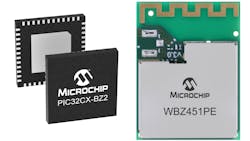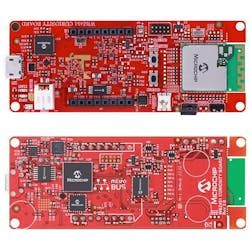Multiprotocol MCU Zeros in on Wireless IoT
What you’ll learn
- What is the PIC32 family?
- How the PIC32CX-BZ2 fits in Microchip’s PIC32 lineu.p
- How it handles multiple wireless protocols.
Check out the other 2023 IDEA Award Nominees.
Microchip’s PIC32 family is a mixed bag of processor architectures brought together by a unified IDE and peripheral set. To most embedded developers who write their code in C or C++, this family looks to be a single platform supported by the MPLAB Harmony V3 framework, which handles multiple communication protocols that the chips work with. The PIC32 family encompasses 32-bit cores including MIP32, Arm Cortex-M0+, and the latest Arm Cortex-M23+.
The PCI32CX-BZ2, the newest addition to the family, is based on a 64-MHz, Arm Cortex-M4F (Fig. 1). The WBZ451 module that uses this chip is available with a printed or external antenna. The chip supports Bluetooth Low Energy 5.2 and 802.15.4, including Zigbee 3.0. The PIC32CX-BZ2, housed in a 48-pin, 7- × 7-mm package, is AEC-Q100 Grade 1 qualified up to 125°C. The WBZ451 has global regulatory certification.
Inside the PIC32CX-BZ2, the Cortex-M4F has access to hardware encryption that includes a random number generator (Fig. 2). There’s 1 MB of embedded flash and its 128 kB of RAM has ECC support. Other peripheral interfaces include QSPI, USART, I2C, SPI, RS-485, and LIN with commander/responder support. There’s an 8-channel, 2-Msample/s 12-bit ADC and an analog comparator on-chip.
PIC32CX-BZ2 and WBZ451 Curiosity Development Board provides a quick way to get started with the chip (Fig. 3). The WBZ451 module has a printed antenna. The board adds a 64-Mb SQPI flash memory, temperature sensor, current measurement header, RGB LED, and a MikroElectronika mikroBUS socket to the mix. It can be powered by a LiPo battery or USB port. There’s also on-board charging support for the battery.
The ability to handle two protocols is useful for IoT applications these days, as Bluetooth is often used to configure and manage devices that are part of an 802.15.4-based network.
Links
About the Author
William G. Wong
Senior Content Director - Electronic Design and Microwaves & RF
I am Editor of Electronic Design focusing on embedded, software, and systems. As Senior Content Director, I also manage Microwaves & RF and I work with a great team of editors to provide engineers, programmers, developers and technical managers with interesting and useful articles and videos on a regular basis. Check out our free newsletters to see the latest content.
You can send press releases for new products for possible coverage on the website. I am also interested in receiving contributed articles for publishing on our website. Use our template and send to me along with a signed release form.
Check out my blog, AltEmbedded on Electronic Design, as well as his latest articles on this site that are listed below.
You can visit my social media via these links:
- AltEmbedded on Electronic Design
- Bill Wong on Facebook
- @AltEmbedded on Twitter
- Bill Wong on LinkedIn
I earned a Bachelor of Electrical Engineering at the Georgia Institute of Technology and a Masters in Computer Science from Rutgers University. I still do a bit of programming using everything from C and C++ to Rust and Ada/SPARK. I do a bit of PHP programming for Drupal websites. I have posted a few Drupal modules.
I still get a hand on software and electronic hardware. Some of this can be found on our Kit Close-Up video series. You can also see me on many of our TechXchange Talk videos. I am interested in a range of projects from robotics to artificial intelligence.




